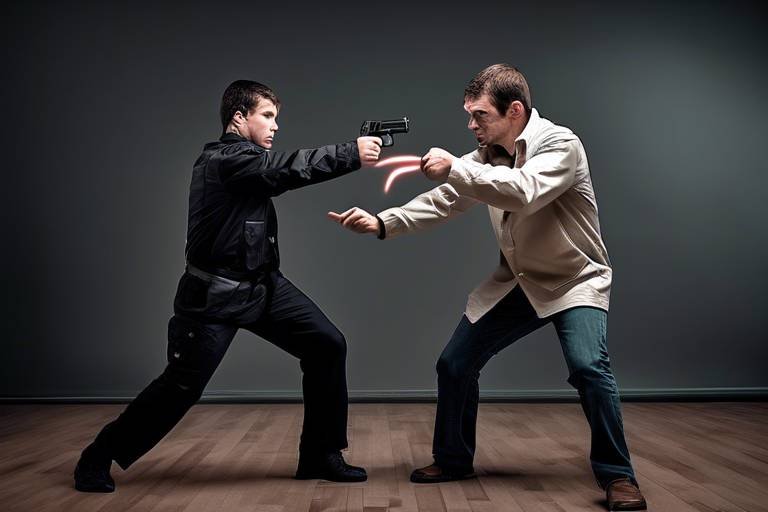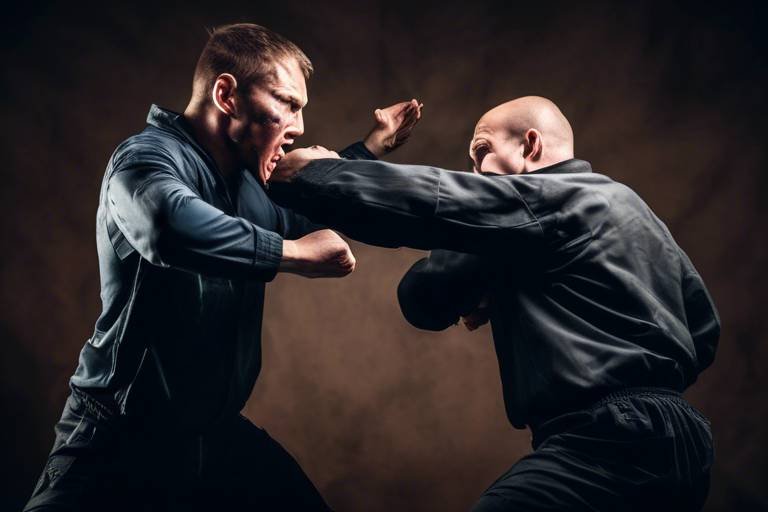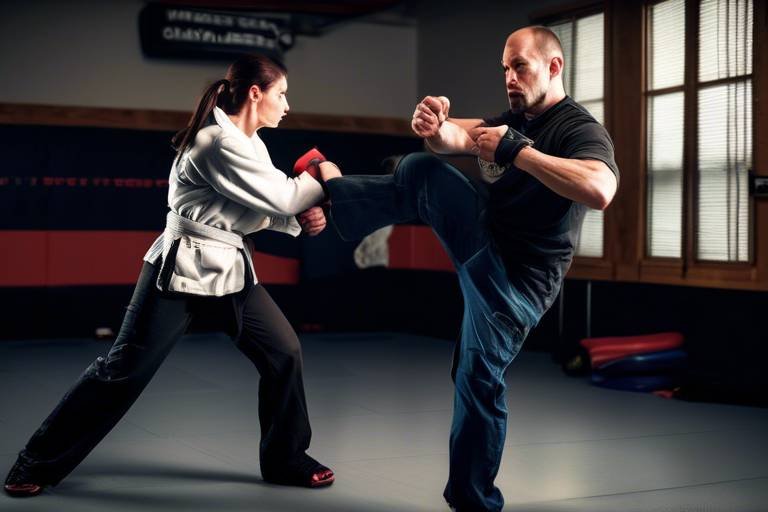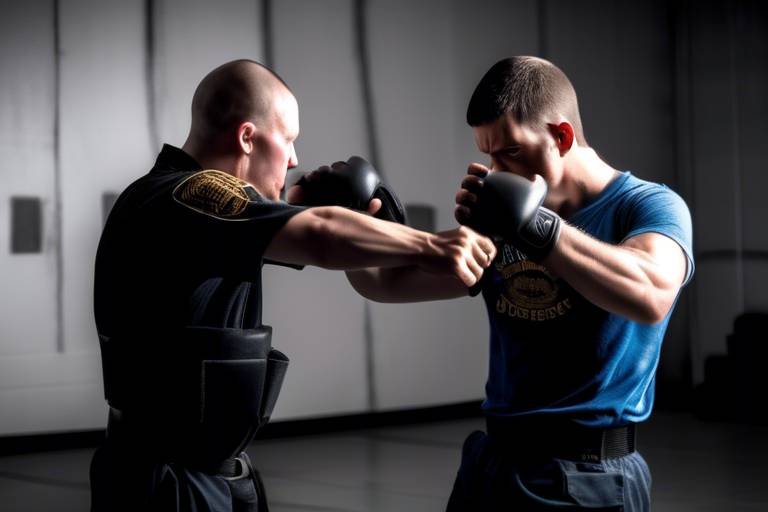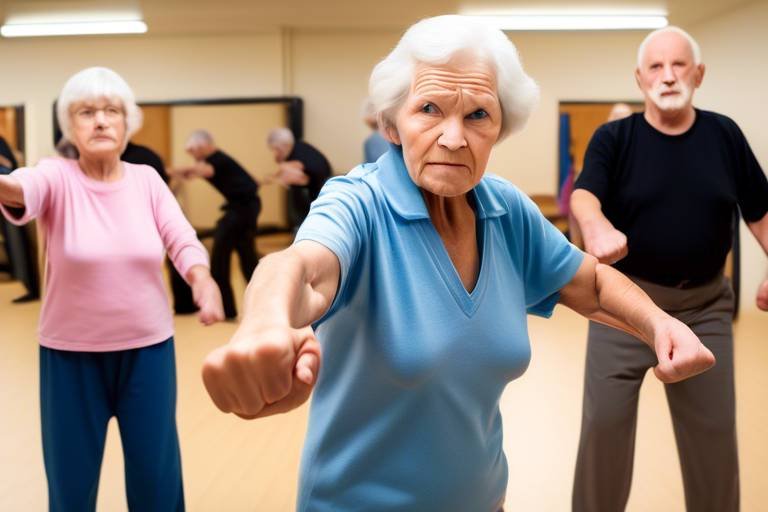Why is Consistency Essential in Self-Defense Training?
When it comes to self-defense training, consistency is not just a buzzword; it's the backbone of success. Imagine trying to learn a musical instrument. If you only practice once a month, will you ever master it? Probably not! The same principle applies to self-defense. Regular practice ensures that the skills you learn are not only retained but also sharpened over time. In a world where danger can strike unexpectedly, having the ability to react instinctively is crucial. This is where the magic of consistency comes into play.
Think of self-defense training as building a house. You wouldn’t want to skip steps in the construction process, right? Each training session lays down another brick, reinforcing your knowledge and abilities. When you practice regularly, you’re not just learning techniques; you’re embedding them into your muscle memory. This means that when the pressure is on, your body knows exactly how to respond without you having to think about it. It’s like driving a car; after enough practice, you don’t have to consciously think about every single action you take.
Moreover, consistency in training creates a solid foundation for confidence. The more you practice, the more familiar you become with the techniques. This familiarity breeds a sense of security. You start to believe in your ability to defend yourself, which is invaluable in a real-life confrontation. Think about it: would you feel more secure facing a threat if you had practiced your techniques hundreds of times versus just a handful? Absolutely! Confidence isn’t just about knowing how to fight; it’s about feeling empowered and ready to take action when needed.
But let’s not forget the mental aspect of self-defense training. Consistent practice helps you confront and manage fear and anxiety. Many people fear the idea of facing an attacker, and that fear can be paralyzing. However, as you train regularly, you become more resilient. You learn to control your emotions and respond effectively, rather than panicking. This transformation is a game-changer. The more you train, the more you prepare yourself not just physically, but mentally for any situation that may arise.
In addition to building skills and confidence, a consistent training schedule creates a safe environment for learning. When you train regularly, you establish a routine that fosters trust among your training partners. This safe space encourages experimentation and growth. You can try new techniques without the fear of judgment, and this freedom is essential for progression. Just like a garden needs constant care to flourish, your self-defense skills need regular attention to grow and thrive.
Lastly, consistency allows you to set personal goals and track your progress. Whether it’s mastering a specific technique or improving your fitness level, having a routine keeps you accountable. You can regularly assess how far you’ve come and identify areas that need improvement. This ongoing evaluation is crucial for enhancing your overall effectiveness in self-defense. After all, the journey of self-defense training is not just about the destination; it’s about the growth you experience along the way.
- How often should I train for self-defense? Consistency is key, so aim for at least 2-3 times a week to see significant improvements.
- Can I practice self-defense techniques at home? Absolutely! Many techniques can be practiced solo, but it's beneficial to train with partners for real-life scenarios.
- What if I miss a training session? Don’t worry! Just get back on track as soon as you can. Consistency is important, but it’s also about making progress over time.
- Is self-defense training only for physical fitness? No, it also enhances mental resilience, confidence, and situational awareness, making you better prepared for various challenges.

The Role of Muscle Memory
Muscle memory is not just a fancy term thrown around in fitness circles; it's a critical component of effective self-defense training. Imagine you're in a high-pressure situation, perhaps facing an unexpected confrontation. Your body needs to react without the luxury of time to think. This is where muscle memory comes into play, allowing you to execute techniques with precision and speed. When practiced consistently, these movements become second nature, almost like breathing. It's as if your body has a built-in autopilot that kicks in when you need it most.
To understand how muscle memory works, think of it as a mental filing cabinet. Each time you practice a self-defense technique, you're filing away that information in your brain. Over time, with consistent practice, you not only reinforce these files, but you also make them easier to access. This is why it's crucial to train regularly. The more frequently you perform the techniques, the more ingrained they become in your muscle memory. Eventually, you won't even have to consciously think about what to do; your body will know. It's like learning to ride a bike—once you've mastered it, you never really forget how to balance and pedal.
Moreover, muscle memory is essential for developing coordination and timing. In self-defense, it's not just about knowing the moves; it's about executing them at the right moment. For instance, consider a simple escape maneuver. If you've practiced it consistently, your body will automatically know how to respond when the time comes. This automaticity can be the difference between successfully defending yourself and being caught off guard.
In addition to enhancing reaction times, muscle memory also plays a pivotal role in skill retention. A study conducted on martial artists showed that those who trained consistently over a period of time retained their skills far better than those who trained sporadically. This highlights the importance of a structured training regimen. By committing to a consistent schedule, you not only improve your current skill set but also ensure that your abilities remain sharp over time.
In conclusion, muscle memory is a vital aspect of self-defense training that allows practitioners to react instinctively in critical situations. By practicing consistently, you reinforce your movements, enhance your coordination, and improve your overall effectiveness in real-life scenarios. So, whether you're just starting your self-defense journey or looking to sharpen your existing skills, remember that consistency is key. It’s the secret ingredient that transforms your training from mere practice into a powerful, instinctive response.

Building Confidence Through Repetition
Repetition is the backbone of mastering any skill, and when it comes to self-defense, this principle holds especially true. Think about it: have you ever tried to learn a new dance move or play a musical instrument? The more you practice, the more natural it feels. This concept applies directly to self-defense techniques. When you consistently practice specific moves, they become ingrained in your muscle memory, allowing you to execute them with confidence and precision when it matters most.
Every time you step onto the training mat or into the dojo, you’re not just going through the motions; you’re building a reservoir of confidence. This confidence isn’t just about knowing how to throw a punch or execute a kick; it’s about feeling secure in your ability to handle unexpected situations. Imagine walking down the street, and suddenly, you find yourself in a confrontation. The hours of repetition in your training kick in, and instead of freezing in fear, you react instinctively. This transformation from anxiety to action is a direct result of the confidence built through consistent practice.
Moreover, repetition allows you to familiarize yourself with various techniques and scenarios. For instance, practicing escape maneuvers repeatedly can make you feel more at ease when faced with a potential threat. You become adept at assessing situations quickly and responding effectively, which is crucial in self-defense. The more you practice, the more you learn about your own strengths and weaknesses, enabling you to refine your skills further.
To illustrate, let’s consider a few key benefits of building confidence through repetition:
- Familiarity with Techniques: Regular practice helps you understand the nuances of each technique, making them easier to recall under pressure.
- Improved Reaction Time: As you repeat movements, your body learns to react faster, which is essential in self-defense situations.
- Increased Comfort Level: Familiarity breeds comfort. The more you practice, the less intimidating self-defense scenarios become.
In essence, repetition is not merely about rote learning; it’s about cultivating a mindset of resilience and readiness. Each training session is an opportunity to reinforce your skills, build your confidence, and prepare yourself for the unexpected. So, the next time you gear up for a training session, remember that every punch thrown and every block practiced is a step toward becoming a more confident and capable self-defense practitioner.
Q: How often should I practice self-defense techniques to build confidence?
A: Ideally, practicing at least two to three times a week can significantly enhance your confidence and skill level. Consistency is key!
Q: Can I practice self-defense techniques at home?
A: Absolutely! Many self-defense techniques can be practiced solo at home, such as shadow boxing or movement drills. Just ensure you have enough space and a safe environment.
Q: What if I feel embarrassed or self-conscious during training?
A: It's completely normal to feel that way, especially when starting out. Remember, everyone is there to learn and improve, just like you. Focus on your progress and celebrate your achievements!

Overcoming Fear and Anxiety
Fear and anxiety are natural human responses, especially when it comes to the unpredictable nature of self-defense scenarios. Imagine standing face-to-face with a potential threat; your heart races, palms sweat, and your mind spirals into a whirlwind of "what ifs." This is where the magic of consistent self-defense training comes into play. By regularly engaging in practice, you not only hone your physical skills but also build a mental fortress against fear. Each training session becomes a stepping stone towards resilience, allowing you to confront your fears head-on.
As you repeat techniques and engage in sparring, you start to notice something remarkable: your body learns to react instinctively. This instinctual response is a product of muscle memory, which is reinforced through consistent practice. The more you train, the more familiar you become with various scenarios, which in turn diminishes the anxiety associated with them. Instead of feeling overwhelmed, you begin to feel empowered. It's like preparing for a big presentation; the more you rehearse, the more confident you become. The same principle applies here.
Moreover, consistent training fosters a supportive community. Training with others who share similar fears and goals creates an environment where individuals can openly discuss their anxieties and learn from one another. This camaraderie not only alleviates feelings of isolation but also provides a safe space to experiment with new techniques without the fear of judgment. In this supportive atmosphere, you can explore your limits, push through your fears, and emerge stronger and more confident.
Additionally, it's essential to recognize that overcoming fear is not a one-time event but an ongoing journey. Just as you wouldn't expect to run a marathon without consistent training, you can't expect to conquer fear overnight. Setting small, achievable goals within your training can be incredibly beneficial. For example, challenge yourself to engage in a new technique each week or participate in a sparring session with a partner. Each small victory builds upon the last, creating a solid foundation of confidence.
In conclusion, consistent self-defense training is a powerful tool in overcoming fear and anxiety. It transforms your body and mind, enabling you to face threats with confidence and composure. Remember, every time you step onto the training floor, you're not just learning to defend yourself; you're also taking a significant step towards conquering your inner fears. So, lace up those training shoes, step onto the mat, and embrace the journey of self-discovery and empowerment.
- How often should I practice self-defense to see improvements? Consistency is key; aim for at least 2-3 sessions per week.
- What if I feel too anxious to train? Start with basic techniques at your own pace, and gradually increase your exposure to more challenging scenarios.
- Can self-defense training help with anxiety in other areas of life? Yes! The skills and confidence gained from training can positively impact various aspects of your life.

Creating a Safe Training Environment
When it comes to self-defense training, creating a safe training environment is not just a luxury; it’s a necessity. Imagine stepping onto the mat, feeling the energy of your teammates, and knowing that you are in a space where everyone is committed to learning and growing together. This sense of safety fosters a culture of trust and respect, allowing practitioners to experiment with techniques without fear of injury or judgment. In such an environment, individuals can push their boundaries, knowing that their training partners are there to support them, not just as competitors but as allies in the journey of self-improvement.
Consistency in training schedules plays a vital role in establishing this safe haven. When practitioners regularly come together, they build rapport and camaraderie, which are essential for creating a positive atmosphere. This regularity not only helps in skill retention but also cultivates a sense of community. Practitioners begin to understand each other's strengths and weaknesses, leading to more effective teamwork. In this supportive environment, individuals can feel free to ask questions, share experiences, and even voice their fears without the worry of being dismissed or ridiculed.
Moreover, a safe training environment encourages the exploration of techniques. In traditional self-defense training, practitioners often focus on specific moves and strategies, but in a safe space, they can explore variations and adaptations that might suit their unique body types and styles. This exploration is crucial because self-defense is not a one-size-fits-all solution; it requires personalization. When individuals feel safe to experiment, they are more likely to discover what works best for them, enhancing their overall effectiveness in real-life situations.
Additionally, having a designated space for practice can significantly impact the quality of training. A well-organized training area with appropriate mats, equipment, and safety gear minimizes the risk of injury. Practitioners should always be reminded of the importance of proper warm-up and cool-down routines, which can be easily integrated into the training schedule. By prioritizing safety, instructors not only protect their students but also instill a sense of responsibility in them—teaching them that self-defense is not just about physical skills but also about maintaining a safe practice environment.
In conclusion, a safe training environment is the bedrock of effective self-defense training. It nurtures confidence, fosters community, and encourages personal growth. By consistently prioritizing safety and support, practitioners can unlock their full potential, making them better prepared for any challenges that may come their way.
- Why is a safe training environment important? A safe training environment is crucial as it allows practitioners to learn and experiment without fear of injury or judgment, fostering trust and camaraderie.
- How can I contribute to a safe training environment? You can contribute by being respectful, supporting your peers, and adhering to safety protocols during training sessions.
- What should I look for in a training facility? Look for a facility that is well-maintained, equipped with safety gear, and has a positive atmosphere where instructors prioritize safety and student well-being.

Setting Personal Goals
Setting personal goals in self-defense training is like laying down a roadmap for your journey. Without a clear destination, it’s easy to lose your way or become disheartened when faced with challenges. When you establish specific, measurable, achievable, relevant, and time-bound (SMART) goals, you create a framework that not only guides your training but also keeps you motivated. For instance, rather than simply saying, “I want to get better at self-defense,” you might set a goal like, “I want to master three new techniques in the next month.” This specificity gives you a clear target to aim for, making your practice sessions more focused and productive.
Moreover, having personal goals allows you to track your progress over time. You can celebrate small victories along the way, which boosts your confidence and reinforces your commitment to training. For example, if one of your goals is to improve your striking accuracy, you can measure your success by keeping a journal of your training sessions. Not only does this provide tangible evidence of your improvement, but it also highlights areas where you might need to dedicate more time and effort.
Another important aspect of setting personal goals is that it encourages accountability. When you share your goals with your training partners or instructors, you create a support system that helps keep you on track. They can offer encouragement, provide feedback, and even challenge you to push your limits. This sense of community can be incredibly motivating, especially during those days when your enthusiasm wanes.
Additionally, it’s essential to revisit and adjust your goals regularly. As you progress in your training, you might find that your initial objectives no longer serve you. Perhaps you’ve mastered the techniques you aimed to learn, and now you’re ready to tackle more advanced skills. By continuously setting new goals, you keep your training fresh and exciting, ensuring that you remain engaged and committed to your self-defense journey.
In conclusion, setting personal goals is a vital component of effective self-defense training. It provides direction, measures progress, fosters accountability, and keeps your motivation high. Remember, every great achievement starts with a clear goal. So take a moment to reflect on what you want to accomplish in your self-defense training and start charting your path to success!
- Why is consistency important in self-defense training? Consistency helps build muscle memory, confidence, and overall effectiveness in real-life situations.
- How can I set effective personal goals for my training? Use the SMART criteria: make your goals Specific, Measurable, Achievable, Relevant, and Time-bound.
- What should I do if I feel stuck in my training? Reassess your goals, seek feedback from instructors, and consider trying new techniques or training methods.
- How often should I train to see improvement? Aim for regular training sessions, ideally several times a week, to build skills and confidence.

Tracking Progress and Improvement
Tracking progress in self-defense training is not just a mundane task; it’s a vital part of the journey that can significantly enhance your overall effectiveness. Imagine embarking on a road trip without a map or GPS; you might enjoy the ride, but you could easily get lost or miss your destination. Similarly, without a proper tracking system, you may find yourself uncertain about your skills and growth. Keeping a record of your training sessions allows you to see how far you’ve come, identify areas that need improvement, and celebrate your achievements.
One effective way to monitor your progress is by maintaining a training journal. In this journal, you can jot down the techniques practiced, the time spent on each session, and personal reflections on what worked well and what didn’t. This not only helps in reinforcing your learning but also serves as a motivational tool. When you flip through the pages and see your progress, it’s like looking at old photos; you can vividly remember the struggles and triumphs that shaped your journey.
Moreover, consider setting specific, measurable goals throughout your training. For instance, instead of simply aiming to “get better at self-defense,” you might set a goal to master a particular technique within a month or to increase your sparring time by 10 minutes each week. By breaking your training into smaller, achievable milestones, you create a roadmap that guides you towards your ultimate goal and provides a sense of accomplishment as you check off each milestone.
To further enhance your tracking, you can utilize technology. There are numerous apps available that allow you to log your workouts, track your progress, and even connect with other practitioners for motivation and support. These tools can help you visualize your improvements over time, providing graphs and statistics that illustrate your growth. For example, you might track your reaction time, endurance levels, or the number of successful techniques executed in sparring sessions.
In addition to personal tracking, seeking feedback from instructors and peers can provide invaluable insights. They can offer perspectives on your strengths and weaknesses that you might overlook. Constructive feedback can be a game changer, allowing you to adjust your training focus and improve your skills more efficiently. Remember, self-defense is not just about physical techniques; it’s also about mental preparedness and adaptability. Tracking your progress helps you cultivate both.
Ultimately, tracking your progress in self-defense training transforms the experience from a mere routine into a structured journey of growth. It empowers you to take charge of your learning, ensuring that you’re not just going through the motions but actively engaging in your development. So, grab that journal, set those goals, and start mapping out your path to becoming a more confident and capable self-defense practitioner!
- How often should I track my progress in self-defense training?
It’s beneficial to track your progress after every training session or at least once a week to ensure consistent improvement. - What should I include in my training journal?
Include details such as techniques practiced, duration of training, personal reflections, and any feedback received from instructors. - Can technology help in tracking my self-defense training?
Absolutely! There are various apps designed for tracking workouts and progress, which can provide visual insights into your development. - Is it important to set goals in self-defense training?
Yes, setting specific and measurable goals helps to keep you motivated and focused on your training journey.

Physical Conditioning and Endurance
When it comes to self-defense, physical conditioning and endurance play a pivotal role in ensuring you can execute techniques effectively and maintain composure during high-stress situations. Imagine being in a scenario where you need to defend yourself; the last thing you want is to be out of breath or unable to react due to fatigue. Consistent training not only hones your skills but also builds the necessary physical attributes that can make a significant difference in real-life encounters.
Engaging in regular self-defense training helps improve your cardiovascular health, which is essential for sustaining energy levels during prolonged physical exertion. Just like a car needs fuel to run, your body requires endurance to function optimally in a self-defense situation. As you train consistently, your body adapts, increasing your stamina and allowing you to perform techniques with greater efficiency. Think of it as building a strong foundation for a house; without it, everything else is at risk of crumbling.
Moreover, self-defense training often incorporates various physical exercises that enhance strength and flexibility. For instance, practicing stances, strikes, and evasive maneuvers not only develops your muscle memory but also strengthens the muscles you rely on during a confrontation. This multifaceted approach to training ensures that you are not just prepared to defend yourself but are also in peak physical condition.
To illustrate the importance of physical conditioning, let’s take a look at the benefits of consistent training:
| Benefit | Description |
|---|---|
| Increased Stamina | Improves your ability to sustain physical activity over longer periods. |
| Enhanced Strength | Builds the muscle power needed for effective self-defense techniques. |
| Improved Flexibility | Reduces the risk of injury and enhances your ability to perform complex movements. |
| Better Coordination | Helps in executing techniques with precision and control. |
Another critical aspect of physical conditioning is injury prevention. A steady training regimen not only enhances your skills but also fortifies your body against potential injuries. By practicing proper techniques and conditioning your body, you significantly reduce the risk of strains and sprains that can occur during both training and real-life encounters. Think of your body as a finely tuned machine; regular maintenance ensures it runs smoothly and efficiently.
Lastly, let’s not forget how consistent training enhances your situational awareness. As you become more physically conditioned, you also become more attuned to your surroundings. This heightened awareness is crucial in self-defense scenarios, as it allows you to recognize potential threats and react appropriately. In essence, physical conditioning and endurance are not just about being fit; they are integral components of a comprehensive self-defense strategy.
- How often should I train for self-defense? Regular training at least 2-3 times a week is recommended to build and maintain skills.
- Can I train for self-defense at home? Yes, there are many effective exercises and techniques you can practice at home, though joining a class can provide valuable guidance.
- What if I have a physical limitation? It’s essential to consult with a professional trainer who can help tailor a program to your specific needs and abilities.
- Is self-defense training effective for everyone? Absolutely! Self-defense training can benefit individuals of all ages and fitness levels.

Injury Prevention
When it comes to self-defense training, one of the most critical yet often overlooked aspects is . You might be thinking, "Why should I worry about injuries when I'm just trying to learn how to defend myself?" Well, let me tell you, the last thing you want is to be sidelined by an injury when you're in the middle of honing your skills. Consistent training not only enhances your techniques but also plays a vital role in keeping you safe from harm.
First off, a steady training regimen allows your body to adapt to the physical demands of self-defense. This adaptation is crucial because it helps build the strength and endurance necessary for executing techniques effectively. Think of your body as a machine; the more you use it correctly, the smoother it runs. Regular practice helps to condition your muscles, joints, and ligaments, reducing the likelihood of strains and sprains during training sessions or real-life confrontations.
Moreover, proper technique is essential in minimizing injury risks. When you consistently practice, you become more aware of your body mechanics and how to execute movements safely. For instance, learning how to fall correctly can significantly reduce the risk of injury during a sparring session. In a controlled environment, you can focus on mastering these techniques without the pressure of a real-world encounter, allowing you to experiment and understand your limits.
It's also worth noting that consistent training helps you recognize when your body is pushing its limits. You learn to listen to your body, which is crucial in preventing overexertion. For example, if you notice persistent soreness or fatigue, you can adjust your training intensity or take a break to recover. This self-awareness is key; it empowers you to train smarter, not just harder.
To illustrate the importance of injury prevention in self-defense training, consider the following table:
| Common Injuries | Prevention Strategies |
|---|---|
| Sprains | Focus on proper warm-up and stretching before training. |
| Strains | Ensure correct technique and avoid overexertion. |
| Fractures | Practice falling techniques and use protective gear when sparring. |
| Joint Injuries | Strengthen surrounding muscles through conditioning exercises. |
In summary, by maintaining a consistent training schedule, you not only sharpen your self-defense skills but also create a solid foundation for injury prevention. You’ll find that the more you train, the more resilient your body becomes, allowing you to defend yourself effectively without the fear of injury looming over you. So, lace up those training shoes and get to work—your future self will thank you for it!
- How often should I train for self-defense?
It's recommended to train at least 2-3 times a week to build consistency and muscle memory. - What should I do if I get injured during training?
Always consult a medical professional and allow your body adequate time to heal before returning to training. - Can I practice self-defense techniques at home?
Absolutely! Just ensure you have a safe space and consider using a mirror to check your form. - Is it necessary to use protective gear during training?
Yes, using protective gear can significantly reduce the risk of injury, especially during sparring sessions.

Enhancing Situational Awareness
When it comes to self-defense, situational awareness is your best friend. Imagine walking down a street and suddenly noticing a group of people acting suspiciously; that gut feeling you get is your intuition kicking in, and it’s all thanks to your heightened awareness. Consistent self-defense training sharpens this crucial skill, allowing you to recognize potential threats before they escalate into dangerous situations. Just like a hawk scanning the ground for its next meal, you learn to observe your surroundings with a keen eye.
In self-defense training, you’re not just learning how to throw punches or execute a perfect kick; you’re also training your brain to be alert and aware of your environment. This means being able to identify not just the obvious threats, but also the subtle cues that something might be off. For instance, are people around you behaving unusually? Is there a sudden change in the atmosphere? Practicing these observations during training sessions helps embed this awareness into your muscle memory, making it second nature when you’re out in the real world.
Moreover, consistent training can improve your ability to assess situations quickly. Think of it as playing a video game where you need to make rapid decisions. The more you play, the better you get at predicting outcomes and reacting accordingly. In self-defense, this means you’re less likely to freeze in a moment of crisis because your brain is already trained to process information swiftly. It’s about developing a reflexive response to your environment, one that’s honed through repetition and practice.
To further enhance your situational awareness, consider integrating these practices into your training:
- Observation Drills: Set up scenarios where you must identify threats or unusual behaviors. This could include role-playing with partners or observing public spaces.
- Mindfulness Exercises: Engage in activities that promote mindfulness, such as meditation or yoga, to help you stay present and aware of your surroundings.
- Scenario-Based Training: Regularly practice different self-defense scenarios that require quick thinking and situational assessment. This can include both verbal de-escalation techniques and physical responses.
In essence, enhancing your situational awareness through consistent training not only prepares you for potential threats but also empowers you to navigate everyday life with greater confidence. You’ll start to notice things you previously overlooked, making you not just a better fighter, but a more aware and astute individual. Remember, the goal of self-defense isn’t just to react; it’s to anticipate and avoid danger whenever possible.
Q1: How often should I train to improve my situational awareness?
A1: Consistency is key! Aim for at least two to three training sessions per week to see significant improvements in your situational awareness.
Q2: Can situational awareness be practiced outside of self-defense training?
A2: Absolutely! You can practice situational awareness in everyday situations, like while walking in a park or shopping. Just remember to observe your surroundings and identify potential threats.
Q3: What are some signs that I should be aware of in my surroundings?
A3: Look for unusual behaviors, people loitering without purpose, or sudden changes in the crowd’s demeanor. Trust your instincts; if something feels off, it probably is.
Q4: How does mindfulness help in improving situational awareness?
A4: Mindfulness helps you stay present and focused, allowing you to better observe and interpret your surroundings. This mental clarity is essential for quick decision-making in self-defense situations.
Frequently Asked Questions
- Why is consistency important in self-defense training?
Consistency in self-defense training is vital because it enhances skill retention and muscle memory. When you practice regularly, your body learns the movements and techniques, allowing you to react instinctively in high-pressure situations. This means that when faced with a real threat, your body can respond without having to think about it, making your reactions quicker and more effective.
- How does muscle memory develop through consistent practice?
Muscle memory develops as you repeat specific movements over time. Each time you practice a technique, your brain sends signals to your muscles, reinforcing the pathways that control those movements. Eventually, these actions become second nature, allowing you to execute them smoothly and efficiently, even under stress.
- Can consistent training help with anxiety during confrontations?
Absolutely! Regular training helps individuals confront and manage fear and anxiety. As you become more familiar with self-defense techniques, your confidence grows, making you feel more secure in your abilities. This increased confidence can significantly reduce panic during confrontations, allowing you to remain calm and focused.
- What role does a safe training environment play in consistency?
A safe training environment is crucial for consistent self-defense practice. It allows practitioners to experiment with techniques without fear of injury or judgment. This supportive atmosphere fosters trust among training partners, encouraging everyone to push their limits and grow together.
- How can I set personal goals for my self-defense training?
Setting personal goals is a great way to stay motivated in your training. Start by assessing your current skills and identifying areas for improvement. Then, create specific, measurable, achievable, relevant, and time-bound (SMART) goals. Regularly track your progress to see how far you've come, which will keep you committed to your training journey.
- What are the benefits of tracking progress in self-defense training?
Tracking your progress allows you to monitor your development over time. It helps you identify your strengths and weaknesses, guiding your future training focus. This not only enhances your overall effectiveness but also keeps you motivated as you see how much you've improved.
- How does physical conditioning relate to self-defense?
Physical conditioning is essential for effective self-defense. Regular training improves cardiovascular health, strength, and flexibility, all of which contribute to your ability to defend yourself. The fitter you are, the better your chances of successfully executing techniques when it matters most.
- Can consistent training help prevent injuries?
Yes, a steady training regimen can significantly reduce the risk of injuries. By practicing proper conditioning and techniques consistently, you strengthen your body and improve your overall physical fitness. This helps prevent strains and sprains during training and real-life encounters, keeping you safe and ready to respond.
- What is the importance of situational awareness in self-defense?
Situational awareness is crucial in self-defense as it enables you to recognize potential threats and react appropriately. Consistent training sharpens this awareness, allowing you to assess your surroundings and identify danger before it escalates. The more you practice, the more instinctively aware you become, enhancing your overall safety.



